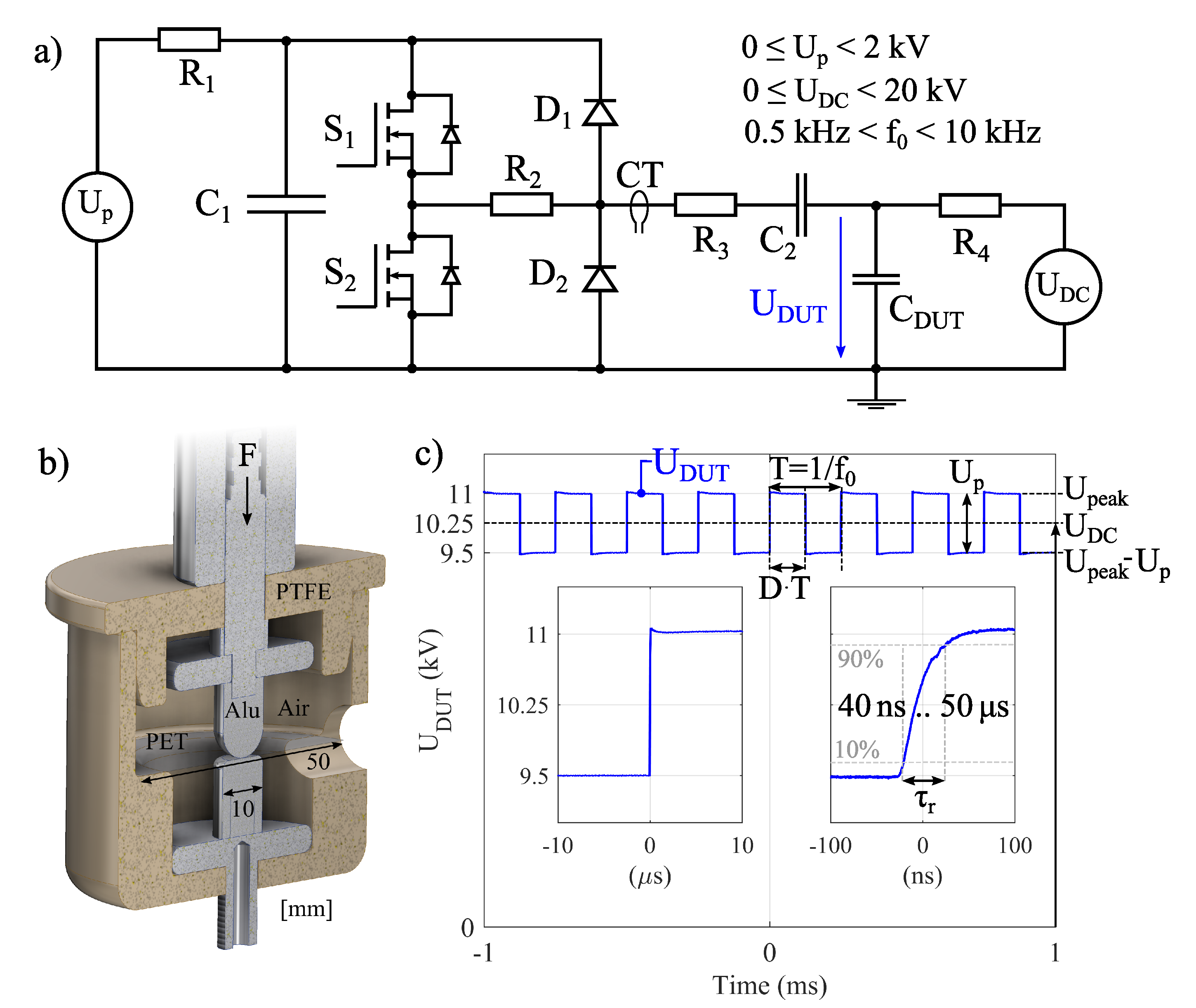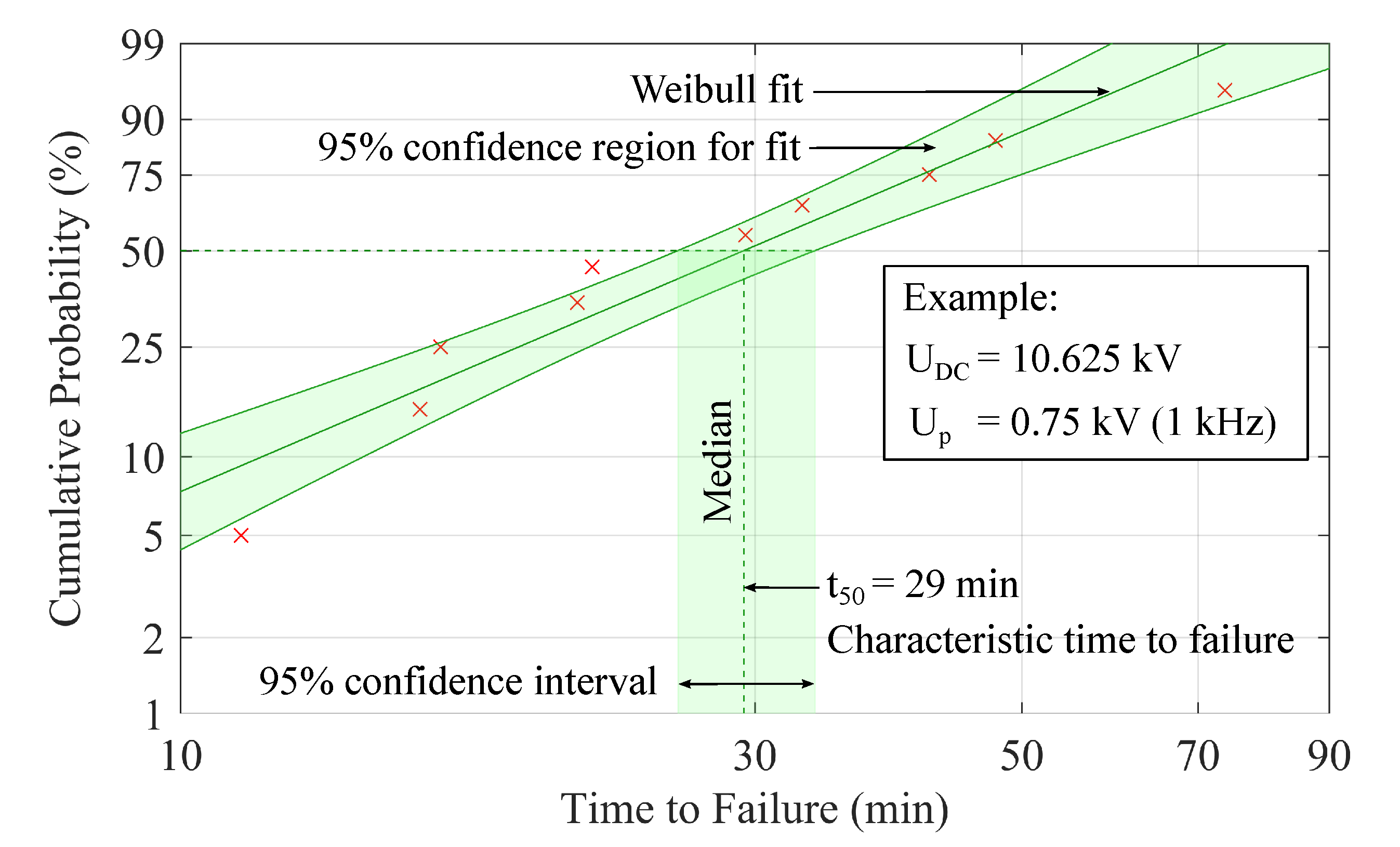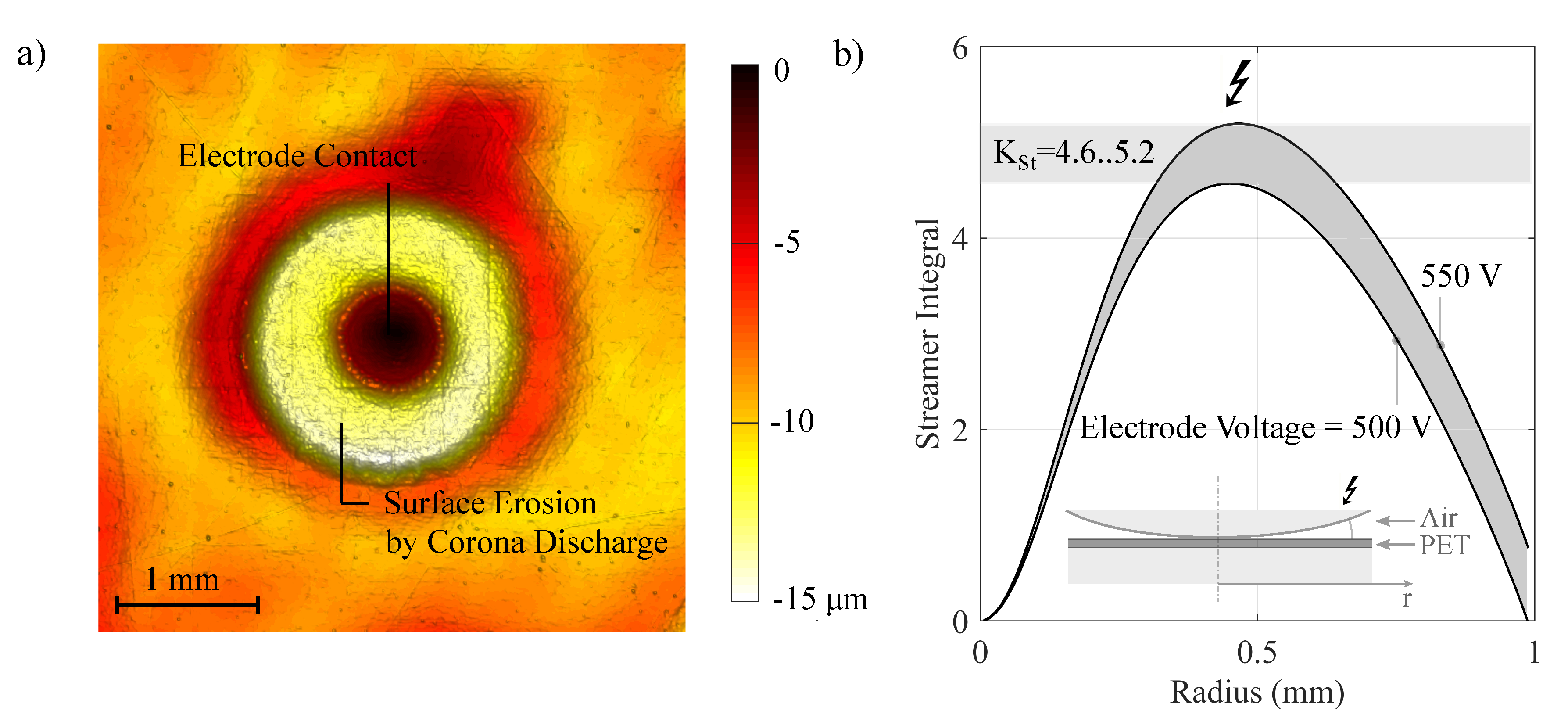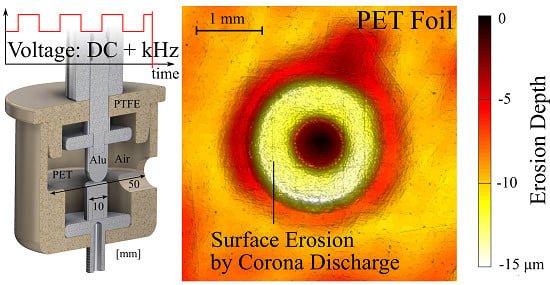Endurance of Polymeric Insulation Foil Exposed to DC-Biased Medium-Frequency Rectangular Pulse Voltage Stress
Abstract
:1. Introduction
- a.
- Enhanced partial discharge (PD) intensity. The number of PDs per unit of time is proportional to the switching frequency. In addition, PD amplitudes are observed to increase with switching speed [11]. Thus, if PD is incepted, the total PD charge and its erosive effect on the insulation material is greatly enhanced when switching frequency and speed are increased.
- b.
- Systemic overvoltages. The broad spectral content of the terminal voltage can excite system resonances, generate standing wave phenomena on electrically long conductors (cable/load impedance mismatch), and lead to strongly nonlinear voltage drops along windings or field-grading layers due to parasitic capacitive couplings [4]. As a result, the electric field stress on certain parts of the insulation can be increased significantly.
- c.
- Excessive insulation temperature. Increased switching speeds broaden the spectral content of the terminal voltage, while a higher switching frequency shifts its frequency spectrum as a whole. Both effects typically entail enhanced dielectric losses. Losses associated with charge migration or the dielectric -relaxation have positive temperature coefficients and can lead to thermal runaway [17]. Moreover, increased capacitive currents can lead to significant heating of (field-grading) semiconductive layers [4]. Even in the absence of thermal runaway, a higher insulation temperature due to increased power (loss) densities enhances thermally activated degradation processes and—especially for organic materials—compromised (di)electric properties. Moreover, the problem of stress cracking and delamination is accentuated.
- d.
- Space charge. Structural aging due to electromechanical stress from the Coulombic interaction between the highly dynamic electrode field (due to repetitive impulse voltages of high slew rate) with space charge evolving under the DC-component of the applied voltage.
2. Methods
2.1. Test Bench
2.2. Sample Preparation and Electrode Geometry
- The stressed volume is small, which allows to avoid a significant heating of the insulation even at high pulse frequencies (quantitative analysis given in Section 2.2.3), and thus to investigate insulation failure outside the thermal aging/thermal breakdown regime;
- The configuration has a high degree of (macroscopic) symmetry, and thus is more easily amenable to numerical estimations of system properties (thermal, electric field, etc.) than more complicated systems (such as twisted enamelled wires);
- The arrangement can be used to investigate the breakdown of polymeric insulation in the presence or absence of PDs without the need for replacing the surrounding air with insulating oil. This is a consequence of the well-defined insulator-electrode configuration and the associated existence of a narrowly scattered value of the inception voltage.
2.2.1. Test Procedure
2.2.2. Statistical Analysis
2.2.3. Maximal Sample Temperature
3. Results
3.1. Dielectric Heating
3.2. Systemic Overvoltages
3.3. Partial Discharge Inception Voltage (PDIV)
3.4. Times to Failure
4. Discussion
5. Conclusions
- PDIV is determined by the pulse peak-peak voltage , but not significantly influenced by the applied DC bias ;
- While the spatial extent of the PDs is correctly predicted by the streamer criterion, the application of the “textbook value” for the streamer constant () significantly overestimates the measured PDIV;
- Repetitive PDs erode the polymer surface (thinning of the foil) and breakdown occurs when the applied DC field exceeds the breakdown strength of the thinned foil;
- In the presence of PDs, the insulation lifetime shows a clear “per pulse” degradation, and it is typically shorter than under a pure DC voltage of the same peak amplitude;
- In the PD regime, the lifetime is inversely proportional to the optical PD intensity (as quantified by a near-UV camera) and scales as with the switching frequency. The “per pulse deterioration” thus decreases with increasing ;
- In the absence of PDs, no evidence is found of a detrimental “per pulse” impact on insulation lifetime (it is observed to be independent of the switching frequency in the investigated range). The processes leading to failure under a pure DC voltage are merely modulated by the changing voltage levels introduced by the rectangular pulse train. Accordingly, the lifetime with pulse modulation is observed to be larger than under pure DC voltage of the same peak amplitude.
Author Contributions
Funding
Acknowledgments
Conflicts of Interest
Abbreviations
| AC | Alternating Current |
| DC | Direct Current |
| MF | Medium Frequency |
| MOSFET | Metal Oxide Field Effect Transistor |
| MV | Medium Voltage |
| PD | Partial Discharge |
| PDIV | Partial Discharge Inception Voltage |
| RH | Relative Humidity |
| TTF | Time To Failure |
| UV | Ultraviolet |
| d | Foil thickness (23 μm) | |
| Switching frequency | ||
| h | W m−2K−1 | Thermal interface conductance |
| k | W m−1K−1 | Thermal conductivity |
| — | Streamer constant | |
| °C | Temperature | |
| °C | Room temperature | |
| — | Effective dielectric permittivity | |
| S m−1 | DC conductivity | |
| Pulse rise/fall time | ||
| Pulse jump voltage | ||
| DC offset voltage |
Appendix A. Indentation of an Elastic Insulation Foil in a Sphere-Plane Electrode Configuration
Appendix B. Dielectric Heating: Estimation of Upper Limit on Temperature Rise

References
- Huber, J.; Kolar, J. Solid-State Transformers: On the Origins and Evolution of Key Concepts. IEEE Ind. Electron. Mag. 2016, 10, 19–28. [Google Scholar] [CrossRef]
- Rosero, J.; Ortega, J.; Aldabas, E.; Romeral, L. Moving towards a more electric aircraft. IEEE Aerosp. Electron. Syst. Mag. 2007, 22, 3–9. [Google Scholar] [CrossRef] [Green Version]
- Oswald, N.; Anthony, P.; McNeill, N.; Star, B. An Experimental Investigation of the Trade-Off between Switching Losses and EMI Generation with Hard-Switched All-Si, Si-SiC and All-SiC Device Combinations. IEEE Trans. Power Electron. 2013, 1, 8885–8993. [Google Scholar] [CrossRef]
- Bengtsson, T.; Dijkhuizen, F.; Ming, L.; Sahlen, F.; Liljestrand, L.; Bormann, D.; Papazyan, R.; Dahlgren, M. Repetitive fast voltage stresses-causes and effects. IEEE Electr. Insul. Mag. 2009, 25, 26–39. [Google Scholar] [CrossRef]
- Cigre Working Group D1.43. Insulation degradation under fast, repetitive voltage pulses. Techn. Brochure 2017, 2017, 703. [Google Scholar]
- IEC 60034-18-42. Rotating Electrical Machines—Part 18-42: Partial Discharge Resistant Electrical Insulation Systems (Type II) Used in Rotating Electrical Machines Fed from Voltage Converters—Qualification Tests; International Standard, Edition 1.0; International Electrotechnical Commission (IEC): Geneva, Switzerland, 2017. [Google Scholar]
- Wang, P.; Cavallini, A.; Montanari, G. The influence of repetitive square wave voltage parameters on enameled wire endurance. IEEE Trans. Dielectr. Electr. Insul. 2014, 21, 1276–1284. [Google Scholar] [CrossRef]
- Moonesan, M.; Jayaram, S.; Cherney, E. Time to failure of medium-voltage form-wound machine turn insulation stressed by unipolar square waves. IEEE Trans. Dielectr. Electr. Insul. 2015, 22, 3118–3125. [Google Scholar] [CrossRef]
- Yin, W. Failure mechanism of winding insulations in inverter-fed motors. IEEE Electr. Insul. Mag. 1997, 13, 18–23. [Google Scholar] [CrossRef]
- Kaufhold, M. Failure mechanism of the interturn insulation of low voltage electric machines fed by pulse controlled inverters. In Proceedings of the 1995 Conference on Electrical Insulation and Dielectric Phenomena, Virginia Beach, VA, USA, 22–25 October 1995; pp. 254–257. [Google Scholar] [CrossRef]
- Hammarström, T.J.; Bengtsson, T.; Blennow, J.; Gubanski, S. Partial discharges in motor wires at PWM voltages of different smoothness. In Proceedings of the 2014 International Symposium on Electrical Insulating Materials, Niigata, Japan, 1–5 June 2014; pp. 184–187. [Google Scholar] [CrossRef] [Green Version]
- Daugherty, R.; Wennerstrom, C. Need for industry standards for AC induction motors intended for use with adjustable-frequency controllers. IEEE Trans. Ind. Appl. 1991, 27, 1175–1185. [Google Scholar] [CrossRef]
- Fabiani, D.; Montanari, G. The effect of voltage distortion on ageing acceleration of insulation systems under partial discharge activity. IEEE Electr. Insul. Mag. 2001, 17, 24–33. [Google Scholar] [CrossRef]
- Koltunowicz, T.; Cavallini, A.; Djairam, D.; Montanari, G.; Smit, J. The influence of square voltage waveforms on transformer insulation break down voltage. In Proceedings of the 2011 Annual Report Conference on Electrical Insulation and Dielectric Phenomena, Cancun, Mexico, 16–19 October 2011; pp. 48–51. [Google Scholar] [CrossRef]
- Sonerud, B.; Bengtsson, T.; Blennow, J.; Gubanski, S. Dielectric heating in insulating materials subjected to voltage waveforms with high harmonic content. IEEE Trans. Dielectr. Electr. Insul. 2009, 16, 926–933. [Google Scholar] [CrossRef]
- Niayesh, K.; Gockenbach, E. On the aging mechanism of solid insulating materials exposed to repetitive high voltage pulses. IEEE Trans. Dielectr. Electr. Insul. 2014, 21, 304–310. [Google Scholar] [CrossRef]
- Guillod, T.; Färber, R.; Rothmund, D.; Krismer, F.; Franck, C.M.; Kolar, J.W. Dielectric Losses in Dry-Type Insulation of Medium-Voltage Power Electronic Converters. IEEE J. Emerg. Select. Top. Power Electron. 2019. [Google Scholar] [CrossRef] [Green Version]
- Fabiani, D.; Montanari, G.; Cavallini, A.; Mazzanti, G. Relation between space charge accumulation and partial discharge activity in enameled wires under PWM-like voltage waveforms. IEEE Trans. Dielectr. Electr. Insul. 2004, 11, 393–405. [Google Scholar] [CrossRef]
- Hudon, C.; Amyot, N.; Lebey, T.; Castelan, P.; Kandev, N. Testing of low-voltage motor turn insulation intended for pulse-width modulated applications. IEEE Trans. Dielectr. Electr. Insul. 2000, 7, 783–789. [Google Scholar] [CrossRef]
- Gao, B.; Wu, G.; He, J.; Lei, K. Investigation on aging mechanism of winding insulation used in inverter-fed traction motors. In Proceedings of the 2007 Annual Report—Conference on Electrical Insulation and Dielectric Phenomena, Vancouver, BC, Canada, 14–17 October 2007; pp. 107–111. [Google Scholar]
- Hanley, T.; Burford, R.; Fleming, R.; Barber, K. A general review of polymeric insulation for use in HVDC cables. IEEE Electr. Insul. Mag. 2003, 19, 13–24. [Google Scholar] [CrossRef]
- Jones, J.; Llewellyn, J.; Lewis, T. The contribution of field-induced morphological change to the electrical aging and breakdown of polyethylene. IEEE Trans. Dielectr. Electr. Insul. 2005, 12, 951–966. [Google Scholar] [CrossRef]
- Zeller, H.; Schneider, W. Electrofracture mechanics of dielectric aging. J. Appl. Phys. 1984, 56, 455–459. [Google Scholar] [CrossRef]
- Crine, J.; Parpal, J.; Lessard, G. A model of aging of dielectric extruded cables. In Proceedings of the 3rd International Conference on Conduction and Breakdown in Solid Dielectrics, Trondheim, Norway, 3–6 July 1989; pp. 347–351. [Google Scholar] [CrossRef]
- Dissado, L.; Mazzanti, G.; Montanari, G. The role of trapped space charges in the electrical aging of insulating materials. IEEE Trans. Dielectr. Electr. Insul. 1997, 4, 496–506. [Google Scholar] [CrossRef]
- Blythe, A.; Bloor, D. Electrical Properties of Polymers, 2nd ed.; Cambridge University Press: Cambridge, UK, 2005. [Google Scholar]
- Yasuda, H.; Stannett, V. Permeation, solution, and diffusion of water in some high polymers. J. Polym. Sci. 1962, 57, 907–923. [Google Scholar] [CrossRef]
- Timoshenko, S.; Goodier, J. Theory of Elasticity, 3rd ed.; McGraw-Hill: New York, NY, USA, 1982. [Google Scholar]
- Waters, N. The indentation of thin rubber sheets by spherical indentors. Br. J. Phys. 1965, 16, 557–563. [Google Scholar] [CrossRef]
- Fan, H.; Li, H. High-Frequency Transformer Isolated Bidirectional DC–DC Converter Modules With High Efficiency Over Wide Load Range for 20 kVA Solid-State Transformer. IEEE Trans. Power Electron. 2011, 26, 3599–3608. [Google Scholar] [CrossRef]
- Montanari, G.C.; Ghinello, I.; Motori, A.; Das Gupta, D. An investigation of conduction mechanisms at high-field in PET. In Proceedings of the IEEE 1997 Annual Report Conference on Electrical Insulation and Dielectric Phenomena, Minneapolis, MN, USA, 19–22 October 1997; Volume 2, pp. 451–454. [Google Scholar]
- Schumann, W. Über das Minimum der Durchbruchfeldstärke bei Kugelelektroden. Electr. Eng. 1923, 12, 593–608. [Google Scholar] [CrossRef]
- Zaengl, W.; Petcharaks, K. Application of Streamer Breakdown Criterion for Inhomogeneous Fields in Dry Air and SF6; Gaseous Dielectrics, VII; Christophorou, L.G., James, D.R., Eds.; Springer: Boston, MA, USA, 1994. [Google Scholar]
- Küchler, A. High Voltage Engineering; Springer: Berlin, Germany, 2018. [Google Scholar]
- Lusuardi, L.; Cavallini, A.; de la Calle, M.G.; Martínez-Tarifa, J.M.; Robles, G. Insulation design of low voltage electrical motors fed by PWM inverters. IEEE Electr. Insul. Mag. 2019, 35, 7–15. [Google Scholar] [CrossRef]
- Pedersen, A. On the electrical breakdown of gaseous dielectrics-an engineering approach. In Proceedings of the Conference on Electrical Insulation and Dielectric Phenomena, Leesburg, VA, USA, 29 October–2 November 1989; pp. 21–58. [Google Scholar] [CrossRef] [Green Version]
- Neagu, E.; Dias, C. Charge injection/extraction at a metal-dielectric interface: Experimental validation. IEEE Electr. Insul. Mag. 2009, 25, 15–22. [Google Scholar] [CrossRef]
- Crowley, J. Simple Expressions for Force and Capcitance for a Conductive Sphere near a Conductive Wall. In Proceedings of the ESA Annual Meeting on Electrostatics, Minneapolis, MN, USA, 17–19 June 2008. [Google Scholar]
- Bahrami, M.; Yovanovich, M.; Culham, J. Thermal Joint Resistances of Nonconforming Rough Surfaces with Gas-Filled Gaps. J. Thermophys. Heat Transf. 2004, 18, 326–332. [Google Scholar] [CrossRef]





© 2019 by the authors. Licensee MDPI, Basel, Switzerland. This article is an open access article distributed under the terms and conditions of the Creative Commons Attribution (CC BY) license (http://creativecommons.org/licenses/by/4.0/).
Share and Cite
Färber, R.; Guillod, T.; Krismer, F.; Kolar, J.W.; Franck, C.M. Endurance of Polymeric Insulation Foil Exposed to DC-Biased Medium-Frequency Rectangular Pulse Voltage Stress. Energies 2020, 13, 13. https://doi.org/10.3390/en13010013
Färber R, Guillod T, Krismer F, Kolar JW, Franck CM. Endurance of Polymeric Insulation Foil Exposed to DC-Biased Medium-Frequency Rectangular Pulse Voltage Stress. Energies. 2020; 13(1):13. https://doi.org/10.3390/en13010013
Chicago/Turabian StyleFärber, Raphael, Thomas Guillod, Florian Krismer, Johann W. Kolar, and Christian M. Franck. 2020. "Endurance of Polymeric Insulation Foil Exposed to DC-Biased Medium-Frequency Rectangular Pulse Voltage Stress" Energies 13, no. 1: 13. https://doi.org/10.3390/en13010013
APA StyleFärber, R., Guillod, T., Krismer, F., Kolar, J. W., & Franck, C. M. (2020). Endurance of Polymeric Insulation Foil Exposed to DC-Biased Medium-Frequency Rectangular Pulse Voltage Stress. Energies, 13(1), 13. https://doi.org/10.3390/en13010013





